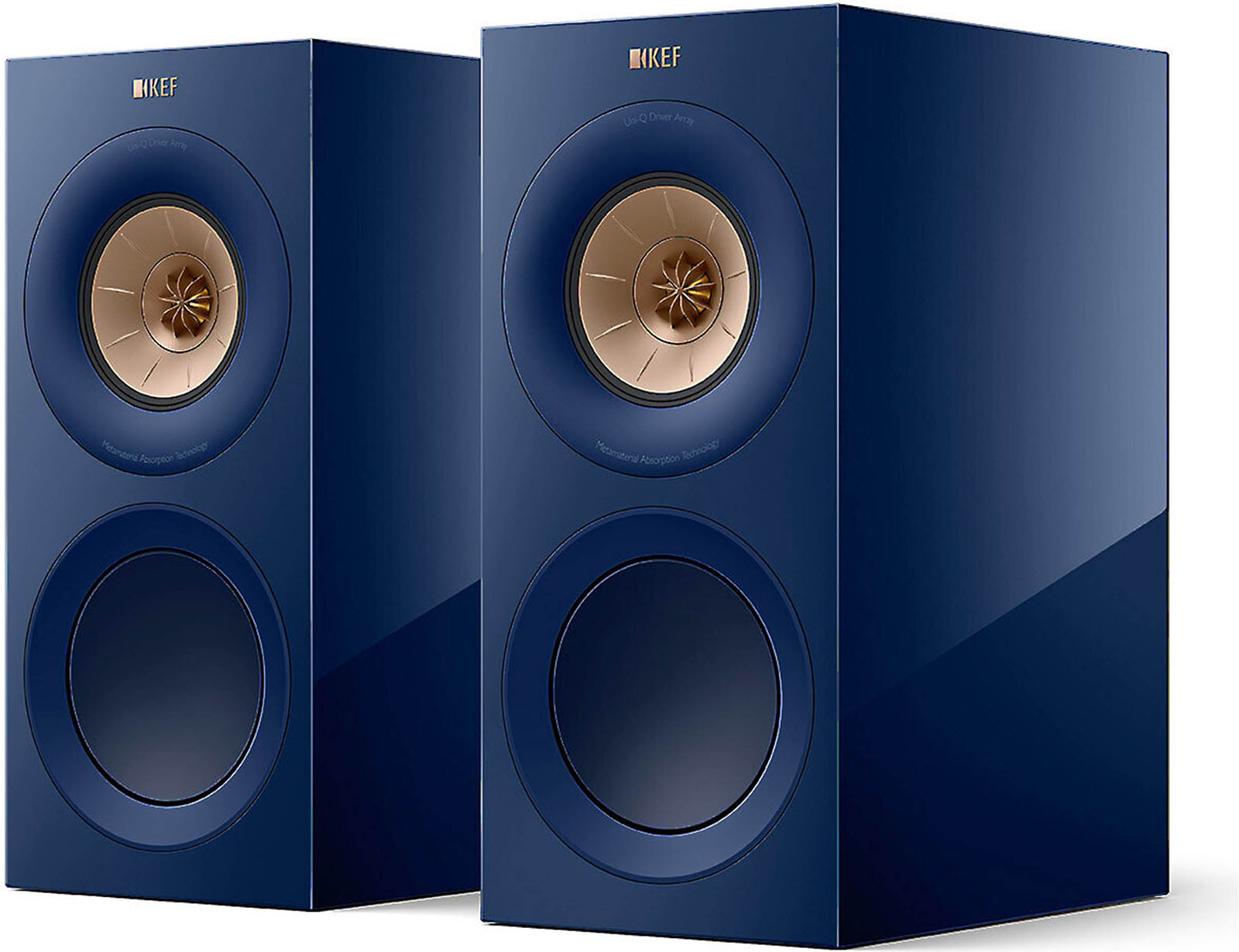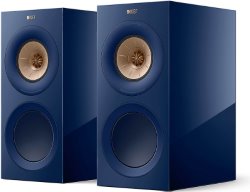KEF R3 Meta Bookshelf Speakers Review
Specs:
| MSRP | $2200 |
| Dimensions (H × W × D) |
16.70” × 7.90” × 13.50” 424mm × 201mm × 343mm |
| Power Type | Passive |
| Frequency Response | 58-28,000 Hz |
Key Takeaways
TLDR Summary: The KEF R3 Meta bookshelf speakers dazzle with their Uni-Q driver's coherence and detail, delivering a spacious soundstage. Their sleek design fits modern aesthetics while the Meta material technology enhances high-resolution audio with less distortion. Bass is tight, though some may crave more heft. Highs are crisp without fatigue. Placement flexibility is a boon, but they do benefit from quality amplification. The R3 Metas are a compelling choice for discerning listeners seeking a high-fidelity experience in a compact form.
KEF R3 Meta: Our Take
The KEF R3 Meta Bookshelf Speakers are a recent addition to KEF's renowned lineup of high-fidelity audio products. Incorporating the innovative Metamaterial Absorption Technology (MAT), these speakers aim to provide an unprecedented level of acoustic purity. MAT is a highly complex maze-like structure, where each of the intricate channels efficiently absorbs a specific frequency. This technology effectively eliminates unwanted sound coming from the rear of the driver, resulting in a cleaner, more natural sound. This unique feature sets the R3 Meta apart from many other bookshelf speakers on the market.
Designed with the audiophile in mind, the KEF R3 Meta sports the brand's signature Uni-Q driver array. This proprietary technology positions the tweeter at the acoustic center of the midrange cone, leading to improved stereo imaging and a wide listening sweet spot. The dispersion of sound is more even across the room, allowing for flexible positioning without compromising sound quality. The coherence between high and low frequencies provides a seamless audio experience that is both detailed and immersive.
Build Quality and Design
The build quality of the KEF R3 Meta is impeccable, as one might expect from a premium brand like KEF. The speakers are solidly constructed, featuring a sleek and modern design that would complement a wide variety of room aesthetics. Attention to detail is evident in every aspect of their construction, from the high-grade finishes to the sturdy binding posts for speaker connections. However, as with any high-end product, they come with a significant price tag, which may be a consideration for some potential buyers.
Related Content
Sound Performance
In terms of sound performance, the KEF R3 Meta delivers on its promises. The bass response is impressive for a bookshelf speaker, tight and controlled but also deep and impactful when the music requires it. Mids are articulate and clear, allowing vocals and instruments to shine through with excellent clarity. Highs are crisp without being harsh, completing a well-rounded sound profile that is both dynamic and nuanced.
Compare to similar speakers:
However, achieving the full potential of these speakers requires careful pairing with the right amplification. They have a nominal impedance of 8 ohms and sensitivity rated at 87dB, meaning that they will benefit from high-quality amplification to drive them adequately. Buyers should be aware that the investment in these speakers may also necessitate an investment in a suitable amplifier or receiver to get the most out of their performance.
One potential con is that some listeners may find these speakers less forgiving when it comes to source material quality or upstream equipment due to their revealing nature. Poor recordings or lower-quality audio sources might be laid bare by the R3 Meta's detailed sound reproduction. This level of transparency can be a double-edged sword and something to consider for those whose collections include a variety of recording qualities.
Comparison With Competitors
When considering other products in the same category, potential buyers might look at alternatives like the Bowers & Wilkins 706 S2 or the Dynaudio Special Forty. Both are respected bookshelf speakers within the same premium segment and offer different sonic characteristics that might appeal to different tastes. The Bowers & Wilkins model is known for its Continuum cone technology and detailed soundstage, while the Dynaudio offers a classic design with its own proprietary driver technology.
Ultimately, choosing between these models often comes down to personal preference in sound signature, aesthetic design, and brand loyalty. It's also important for buyers to consider compatibility with existing audio equipment, listening room characteristics, and overall budget when making their decision.
The KEF R3 Meta Bookshelf Speakers stand as an exemplary choice for audio enthusiasts seeking high-end performance in a compact form. While they demand a premium price and may require careful system matching, their innovative MAT technology and Uni-Q drivers offer a listening experience that many will find unparalleled. It is this blend of cutting-edge engineering and audio fidelity that makes the R3 Meta an attractive option for those pursuing acoustic excellence in their personal listening spaces.
Frequently Asked Questions
What are the key improvements in the KEF R3 Meta over the original R3 series?
The KEF R3 Meta speakers build upon the already lauded R3 series with some significant enhancements, particularly in their use of Metamaterial Absorption Technology (MAT). This cutting-edge acoustic innovation is designed to absorb unwanted sound frequencies coming from the rear of the driver, which in turn minimizes distortion and provides a purer, more natural sound. Essentially, the MAT acts as an acoustic black hole, trapping certain frequencies that would otherwise muddy the sonic presentation. Another key improvement is likely found in the refinements to the Uni-Q driver array, a hallmark of KEF's design philosophy, which aims to improve the integration between the tweeter and midrange driver for a more seamless and coherent soundstage.
How does the Uni-Q driver design in the KEF R3 Meta enhance the listening experience?
The Uni-Q driver is a staple of KEF's approach to speaker design, and in the R3 Meta, it continues to serve a pivotal role in delivering a cohesive listening experience. This proprietary technology places the tweeter in the acoustic center of the midrange cone, which enables the R3 Meta to produce a more detailed and integrated sound. The result is that the sweet spot is greatly enlarged, providing a more immersive and three-dimensional sound that doesn't tie the listener to a fixed listening position. Moreover, the Uni-Q driver's improved dispersion characteristics ensure that the sound remains consistent across different listening angles, making the R3 Meta a flexible choice for various room sizes and shapes.
Can the KEF R3 Meta speakers be integrated into a surround sound system, and if so, what are the considerations for doing this?
Absolutely, the KEF R3 Meta speakers are versatile enough to be integrated into a multi-channel surround sound setup, acting as front or surround channels depending on the user's preference and system configuration. When incorporating these bookshelf speakers into a surround array, it's important to consider complementary components that can match the R3 Meta's sonic characteristics. For the best coherent sound experience, one should look towards other speakers in the KEF lineup, particularly those that share similar drivers and design philosophies. It's also critical to pair them with a high-quality AV receiver that can properly drive them and manage the crossover settings with precision, ensuring a balanced and immersive cinematic experience.

